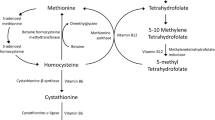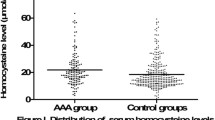Abstract.
Mild hyperhomocysteinemia is a probable risk factor for atherosclerotic diseases and stroke. Recently, associations of elevated plasma homocysteine concentrations in the acute phase and of MTHFR 677 TT genotype with spontaneous cervical artery dissections (sCAD) have been reported. The purpose of this study was to test this hypothesis in the currently largest sample of patients with sCAD, taking into account known factors influencing plasma homocysteine levels. Ninety-five patients with past sCAD were compared with 95 age- and sex-matched healthy individuals. Homocysteine, vitamin B6, B12, folate, and polymorphisms of methylenetetrahydrofolate reductase (MTHFR C677T), cystathionine β-synthase (CBS 844ins68bp) and methylenetetrahydrofolate dehydrogenase/methenyltetrahydrofolate cyclohydrolase/formyltetrahydrofolate synthetase (MTHFD1 G1958A) were assessed and any associations were analysed using multivariate statistics. The occurrence of sCAD was associated with elevated homocysteine levels with an odds ratio of 1.327 per 20 % percentile. Homocysteine levels were influenced by gender, smoking status, occurrence of hypertension, vitamin B12 and folate levels, and by the MTHFR TT genotype. MTHFR, CBS 844ins68bp, and MTHFD1 G1958A genotype were not independently associated with the occurrence of sCAD. These data suggest that elevated homocysteine is associated with the occurrence of sCAD. The MTHFR C677T polymorphism is associated with the homocysteine level.
Similar content being viewed by others
References
Akar N, Akar E, Ozel D, Deda G, Sipahi T (2001) Common mutations at the homocysteine metabolism pathway and pediatric stroke. Thromb Res 102:115–120
Assmann G, Schulte H (1988) The Prospective Cardiovascular Munster (PROCAM) study: prevalence of hyperlipidemia in persons with hypertension and/or diabetes mellitus and the relationship to coronary heart disease. Am Heart J 116:1713–1724
Ay H, Arsava EM, Tokgozoglu SL, Ozer N, Saribas O (2003) Hyperhomocysteinemia is associated with the presence of left atrial thrombus in stroke patients with nonvalvular atrial fibrillation. Stroke 34:909–912
Berger K, Schulte H, Stogbauer F, Assmann G (1998) Incidence and risk factors for stroke in an occupational cohort: the PROCAM Study. Prospective Cardiovascular Muenster Study. Stroke 29:1562–1566
Bogousslavsky J, Pierre P (1992) Ischemic stroke in patients under age 45. Neurol Clin 10:113–124
Brandt T, Orberk E, Weber R, Werner I, Busse O, Muller BT, Wigger F, Grau A, Grond-Ginsbach C, Hausser I (2001) Pathogenesis of cervical artery dissections: association with connective tissue abnormalities. Neurology 57:24–30
Brody LC, Conley M, Cox C, Kirke PN, McKeever MP, Mills JL, Molloy AM, O’Leary VB, Parle-McDermott A, Scott JM, Swanson DA (2002) A polymorphism, R653Q, in the trifunctional enzyme methylenetetrahydrofolate dehydrogenase/methenyltetrahydrofolate cyclohydrolase/formyltetrahydrofolate synthetase is a maternal genetic risk factor for neural tube defects: report of the Birth Defects Research Group. Am J Hum Genet 71:1207–1215
Cook JW, Taylor LM, Orloff SL, Landry GJ, Moneta GL, Porter JM (2002) Homocysteine and arterial disease. Experimental mechanisms. Vascul Pharmacol 38:293–300
de Bree A, Verschuren W, Bjorke-Monsen A, van der Put N, Heil S, Trijbels F, Blom H (2001) Association between B vitamin intake and plasma homocysteine concentration in the general Dutch population aged 20–65 y. Am J Clin Nutr 77:687–693
de Bree A, Verschuren W, Blom H, Kromhout D (2001) Lifestyle factors and plasma homocysteine concentrations in a general population sample. Am J Epidemiol 154:150–154
de Franchis R, Fermo I, Mazzola G, Sebastio G, Di Minno G, Coppola A, Andria G, D’Angelo A (2000) Contribution of the cystathionine beta-synthase gene (844ins68) polymorphism to the risk of early-onset venous and arterial occlusive disease and of fasting hyperhomocysteinemia. Thromb Haemost 84:576–582
Dziewas R, Konrad C, Drager B, Evers S, Besselmann M, Ludemann P, Kuhlenbaumer G, Stogbauer F, Ringelstein EB (2003) Cervical artery dissections—clinical features, risk factors, therapy and outcome in 126 patients. J Neurol 250:1179–1184
Eikelboom JW, Hankey GJ, Anand SS, Lofthouse E, Staples N, Baker RI (2000) Association between high homocyst(e)ine and ischemic stroke due to large- and small-artery disease but not other etiologic subtypes of ischemic stroke. Stroke 31:1069–1075
Ford ES, Smith SJ, Stroup DF, Steinberg KK, Mueller PW, Thacker SB (2002) Homocyst(e)ine and cardiovascular disease: a systematic review of the evidence with special emphasis on casecontrol studies and nested case-control studies. Int J Epidemiol 31:59–70
Gallai V, Caso V, Paciaroni M, Cardaioli G, Arning E, Bottiglieri T, Parnetti L (2001) Mild hyperhomocyst(e)inemia: a possible risk factor for cervical artery dissection. Stroke 32:714–718
Geisel J, Zimbelmann I, Schorr H, Knapp JP, Bodis M, Hubner U,Herrmann W (2001) Genetic defects as important factors for moderate hyperhomocysteinemia. Clin Chem Lab Med 39:698–704
Homocysteine Studies Collaboration (2002) Homocysteine and risk of ischemic heart disease and stroke: a meta-analysis. JAMA 288:2015–2022
Howard VJ, Sides EG, Newman GC, Cohen SN,Howard G, Malinow MR, Toole JF (2002) Changes in plasma homocyst(e)ine in the acute phase after stroke. Stroke 33:473–478
Husemoen LL, Thomsen TF, Fenger M, Jorgensen HL, Jorgensen T (2003) Contribution of thermolabile methylenetetrahydrofolate reductase variant to total plasma homocysteine levels in healthy men and women. Genet Epidemiol 24:322–330
Jacques PF, Bostom AG, Wilson PW, Rich S, Rosenberg IH, Selhub J (2001) Determinants of plasma total homocysteine concentration in the Framingham Offspring cohort. Am J Clin Nutr 73:613–621
Kelly PJ, Furie KL, Kistler JP, Barron M, Picard EH, Mandell R, Shih VE (2003) Stroke in young patients with hyperhomocysteinemia due to cystathionine beta-synthase deficiency. Neurology 60:275–279
Kelly PJ, Rosand J, Kistler JP, Shih VE, Silveira S, Plomaritoglou A, Furie KL (2002) Homocysteine, MTHFR 677C → T polymorphism, and risk of ischemic stroke: results of a meta-analysis. Neurology 59:529–536
Kristensen B, Malm J, Carlberg B, Stegmayr B, Backman C, Fagerlund M, Olsson T (1997) Epidemiology and etiology of ischemic stroke in young adults aged 18 to 44 years in northern Sweden. Stroke 28:1702–1709
Lim U, Cassano P (2002) Homocysteine and blood pressure in the Third National Health and Nutrition Examination Survey, 1988–1994. Am J Epidemiol 156:1105–1113
Lindgren A, Brattstrom L, Norrving B, Hultberg B, Andersson A, Johansson BB (1995) Plasma homocysteine in the acute and convalescent phases after stroke. Stroke 26:795–800
Moller J, Nielsen GM, Tvedegaard KC, Andersen NT, Jorgensen PE (2000) A meta-analysis of cerebrovascular disease and hyperhomocysteinaemia. Scand J Clin Lab Invest 60:491–499
Nygard O, Refsum H, Ueland PM, Vollset SE (1998) Major lifestyle determinants of plasma total homocysteine distribution: the Hordaland Homocysteine Study. Am J Clin Nutr 67:263–270
Pezzini A, Del Zotto E, Archetti S, Negrini R, Bani P, Albertini A, Grassi M, Assanelli D, Gasparotti R, Vignolo LA, Magoni M, Padovani A (2002) Plasma homocysteine concentration, C677T MTHFR genotype, and 844ins68bp CBS genotype in young adults with spontaneous cervical artery dissection and atherothrombotic stroke. Stroke 33:664–669
Saw SM, Yuan JM, Ong CN, Arakawa K, Lee HP, Coetzee GA, Yu MC (2001) Genetic, dietary, and other lifestyle determinants of plasma homocysteine concentrations in middle-aged and older Chinese men and women in Singapore. Am J Clin Nutr 73:232–239
Schievink WI, Mokri B, Whisnant JP (1993) Internal carotid artery dissection in a community. Rochester, Minnesota, 1987–1992. Stroke 24:1678–1680
Tsai MY, Bignell M, Yang F, Welge BG, Graham KJ, Hanson NQ (2000) Polygenic influence on plasma homocysteine: association of two prevalent mutations, the 844ins68 of cystathionine beta-synthase and A(2756)G of methionine synthase,with lowered plasma homocysteine levels. Atherosclerosis 149:131–137
Zhang G, Dai C (2001) Gene polymorphisms of homocysteine metabolismrelated enzymes in Chinese patients with occlusive coronary artery or cerebral vascular diseases. Thromb Res 104:187–195
Author information
Authors and Affiliations
Corresponding author
Rights and permissions
About this article
Cite this article
Konrad, C., Müller, G.A., Langer, C. et al. Plasma homocysteine, MTHFR C677T, CBS 844ins68bp, and MTHFD1 G1958A polymorphisms in spontaneous cervical artery dissections. J Neurol 251, 1242–1248 (2004). https://doi.org/10.1007/s00415-004-0523-z
Received:
Revised:
Accepted:
Issue Date:
DOI: https://doi.org/10.1007/s00415-004-0523-z




